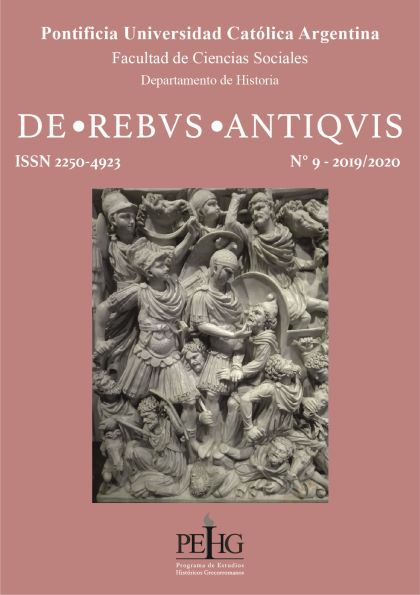Augustus: Representations, Representativeness and Otherness in the legitimation of Princeps’ power
Keywords:
Principate, Augustus, Representations, Representativeness, CoinsAbstract
Augustus, considered by many to be the first Roman Emperor, is the focus of numerous analyzes, which, in turn, exposes numerous facets of this ruler. This article proposes a brief essay about how discursive images and material creations, such as coins, were fundamental to legitimize the power of this Princeps, his representations and representativeness.Downloads
References
REFERÊNCIAS BIBLIOGRÁFICAS:
AUGUSTUS. (2007). Res Gestae Divi Augusti. Trad.: John Scheid. Paris: Belle Lettres.
DION CASSIUS. (2011) Histoire Romaine. Traducción, Introdución et Notes par Guy Lachenaud et Marianne Coudry. Paris: Les Belles Lettres.
FLORO. (2000) Epítome de la Historia de Tito Livio. Introducción, traducción y notas de Gregorio Hinojo Andrés y Isabel Moreno Ferrero. Madrid: Gredos.
PLUTARCO, SUETÔNIO. (2007). Vidas de César. Tradução e notas de Antônio da Silveira Mendonça e Ísis Borges da Fonseca. São Paulo: Estação Liberdade.
PLUTARQUE. (1995) Vies Parallèles I. Traduction: J. Alexis Pierron. Revue et Corrigiée par Françoise Frazier.Introduction, notices, notes, bibliographie et chronologie par Jean Sirinelli. Paris: Flammarion.
SUENTONNIUS. (2009). The Lives of Caesars. Oxford: Oxford University Press.
VELÉIO PATÉRCULO. (2001). História Romana I. Trad. Maria Assunción Sánchez Manzano. Madrid: Gredos.
______. (2001). História Romana II. Trad. Maria Assunción Sánchez Manzano. Madrid: Gredos.
OBRAS GERAIS:
BACELÓ, J. - CATANIA, M. (2003). Las Bases del Poder de los Líderes Carismáticos durante La Crisis de La República Romana. S.I.A.C. In: ROJO, E. (org). Representaciones Identitárias de la Roma Antigua. Tucumán: Instituto Interdisciplinaria de literatura argentina y comparadas, 91-100.
BARTON, T. (1995). Augustus and Capricorn: Astrological Polyvalency and Imperial Rhetoric. Journaul of Roman Studies, 85, 33-51.
BOBBIO, N. (1998). Dicionário de Política. Brasília: Editora UnB.
CHARTIER, R. (1990). A História Hoje: dúvidas, desafios, propostas. Estudos Históricos (Rio de Janeiro), n.13, 108.
______ (1991). O mundo como representação. Estudos Avançados (Rio de Janeiro), n.11, 5.
CLARKE, J. (2003). Art in the Lives of ordinary Romans. California: University of California Press.
FALCON, Francisco J.C. (1997). História das ideias. In: CARDOSO, S.F; VAINFAS, R. (org.). Domínios da história. Rio de janeiro: Ed. Campus, p.91-94.
GALINSKY, K. (2012). Augustus. Introduction to the Life of an Emperor. New York: Cambridge University Press.
LEVICK, B. (2010). Augustus: Image and Substance. London: Pearson.
LICTH, L. - RAMSEY, J.T. (1997). The Comet of 44 B.C. and Caesar’s Funeral Games. Harvard Smithsonian Center for Astrophysics: Atlanta.
MARTINS, P. (2011). Imagem e Poder. Considerações sobre as Representações de Otávio Augusto. São Paulo: Edusp.
PRADO, J.B.T. (2011). É Ver para Fazer Crer. In MARTINS, P. (2011). Imagem e Poder. Considerações sobre as Representações de Otávio Augusto. São Paulo: Edusp.
SPARAVIGNA, A. (2019). Octavian Augustus at Apollonia and the statement of his astrological sign. Zenodo, August 2019, 1-5.
Downloads
Published
How to Cite
Issue
Section
License










